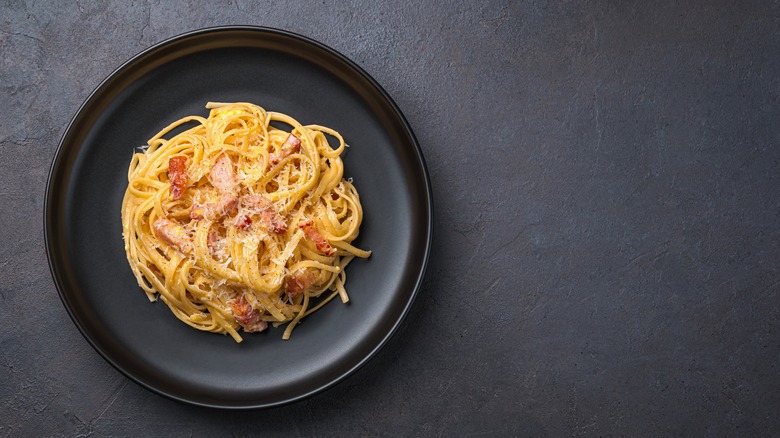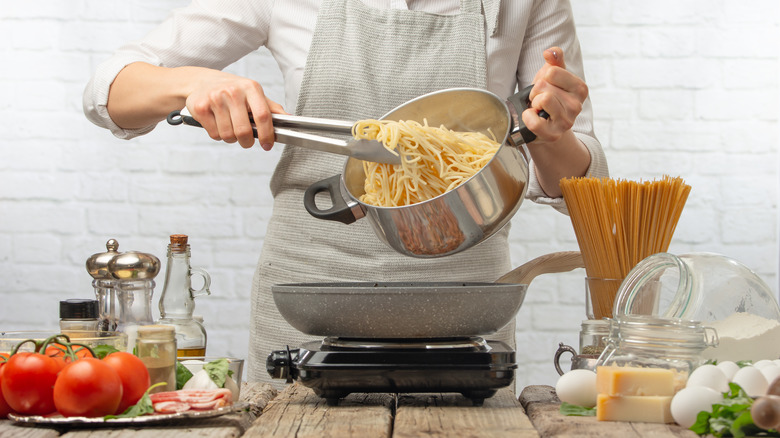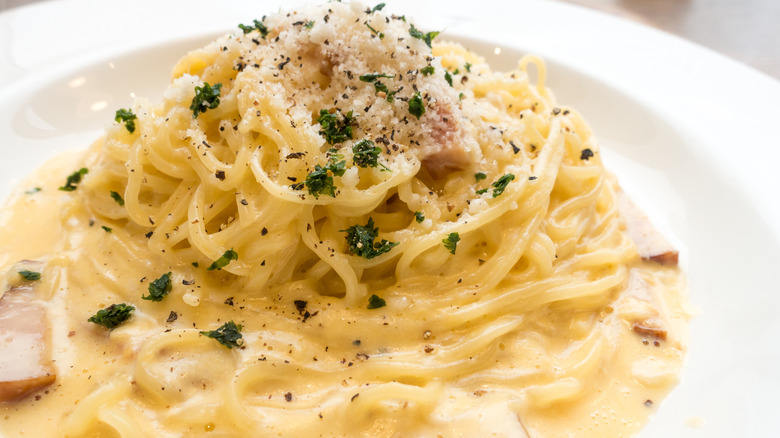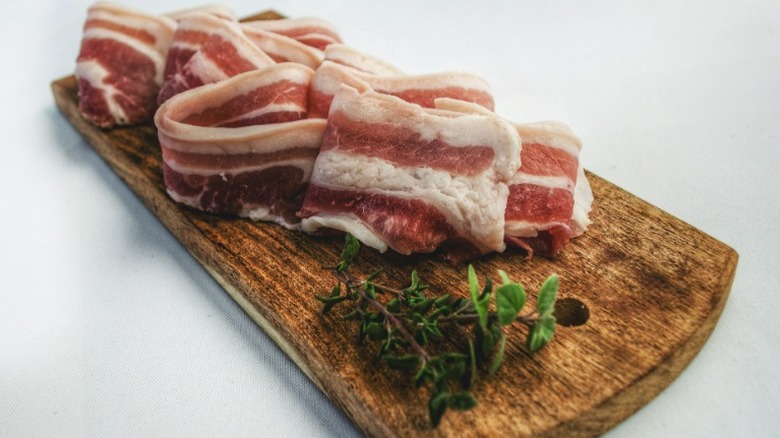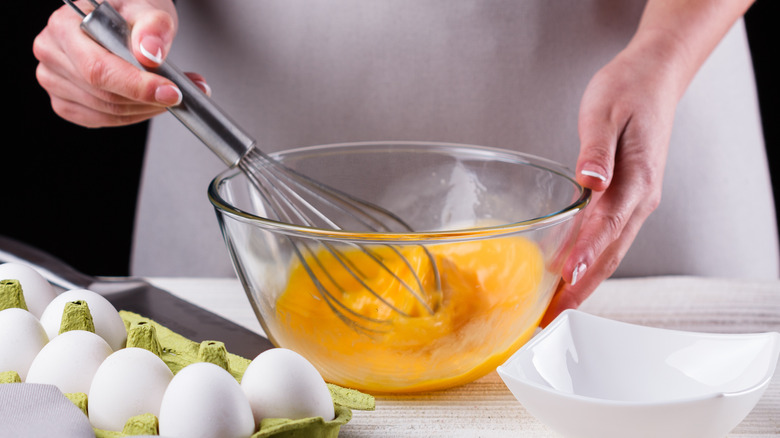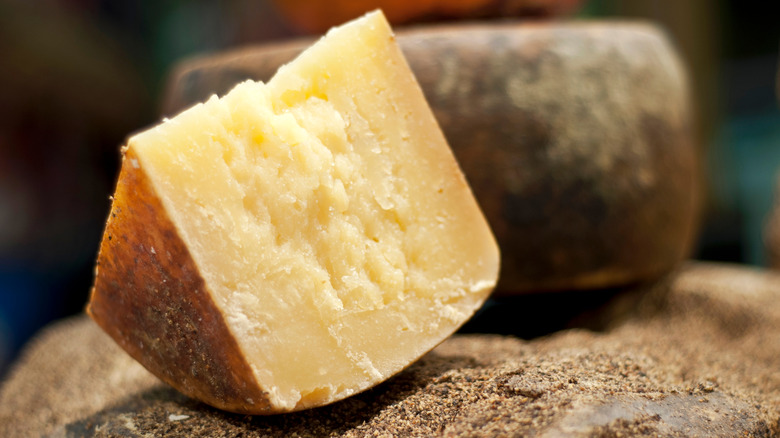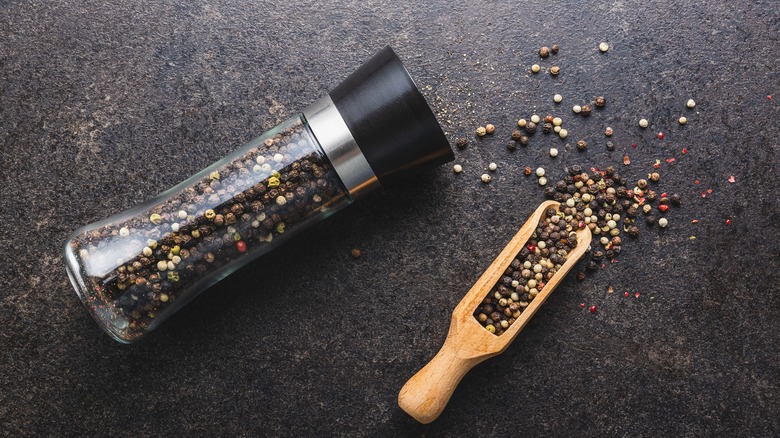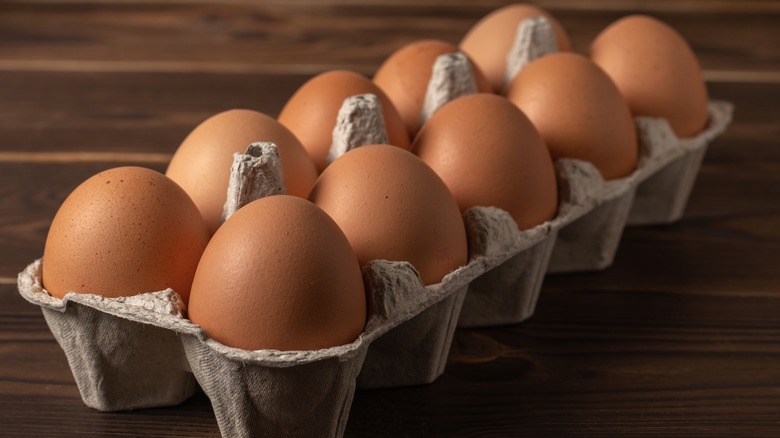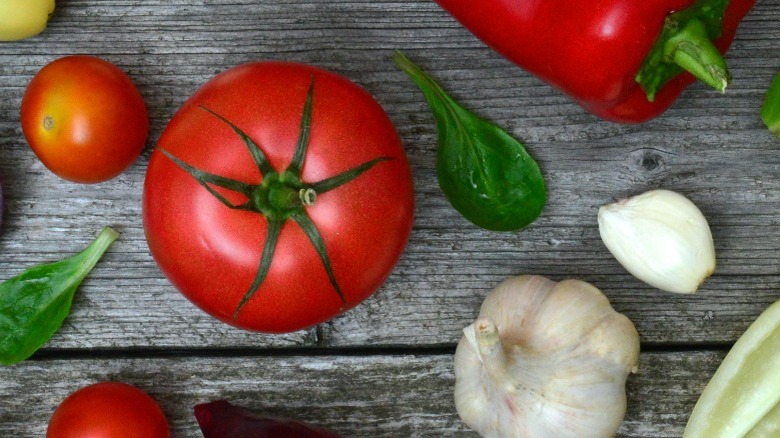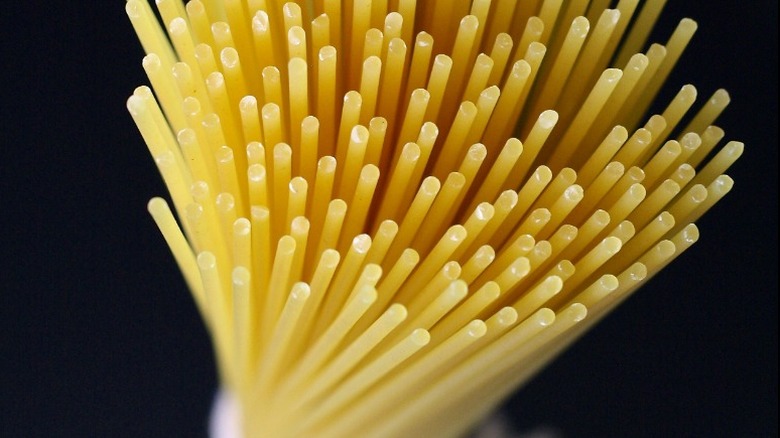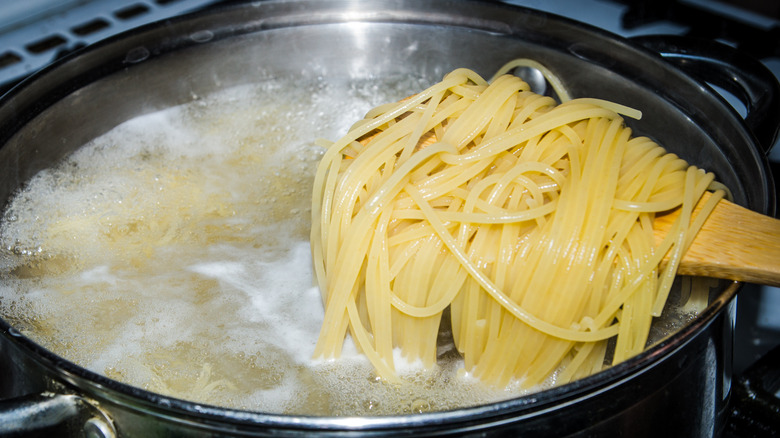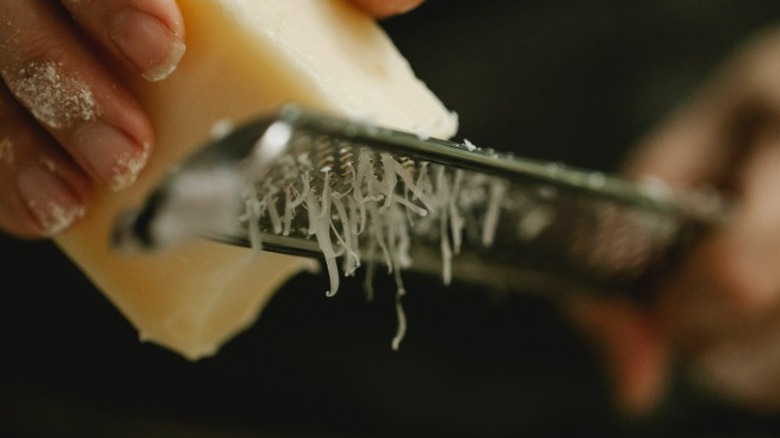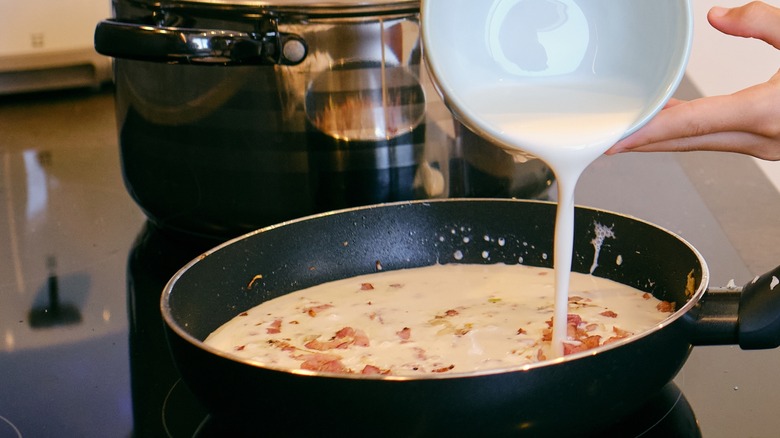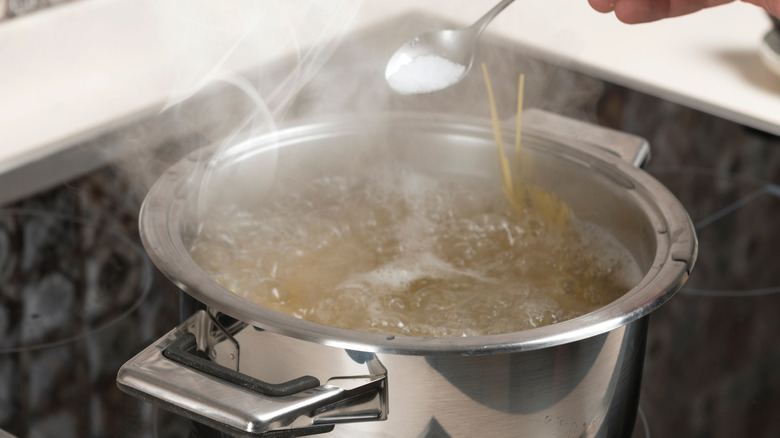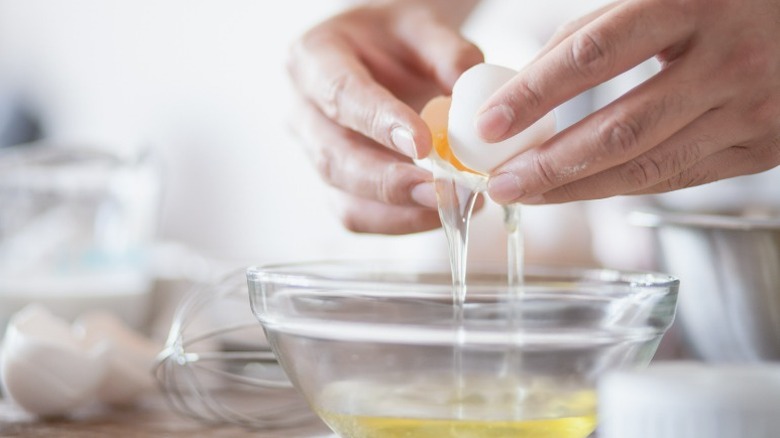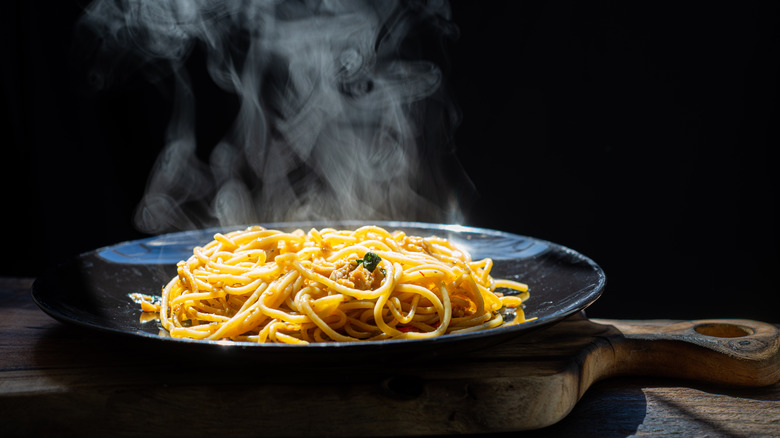15 Mistakes That Are Ruining Your Carbonara
Carbonara is a classic Italian dish. But that doesn't mean it's an easy one to make, especially if you are making it in a Western country like the United States or Canada. Some key ingredients may be more challenging to locate in these areas, but you'd be doing your carbonara a great disservice to swap them out with more readily available options.
Working with eggs is one of the most complicated parts of making carbonara pasta. There are some tricks to getting them right: There are things you should and shouldn't do when making carbonara, but that isn't the only challenging aspect of this dish. And some simple things will kick things up a notch and make your carbonara the best version of itself. There are some tips that you definitely knew about carbonara and also some things you should avoid if you don't want to offend your family members or your guests.
1. Adding your eggs while the pasta is still on the heat
This is one of the most common mistakes when making carbonara. It is very easy to end up with pasta a la scrambled eggs instead. While you want your eggs to be cooked, you don't want them scrambled or curdled.
According to a user on Quora, the trick to getting the eggs to coat your noodles and cook into a sauce is to remove your pan from the heat before adding the egg and cheese mixture. People often turn down the heat but leave the pan on the stove. This produces too much heat and will cook your eggs too quickly. You want them to cook gradually, using the residual heat from your pasta.
One Reddit user recommends using a slightly different approach: Remove the pasta from the pan and toss it with the egg and cheese mixture in a separate bowl. They do caution that you must stir them together quickly so the sauce heats through, but overall, it's an excellent way to avoid scrambling your eggs.
2. Not coating your pasta completely
So, you've tossed your pasta with your egg and cheese sauce and managed not to turn it into scrambled eggs. But what's the point in making that delicious sauce if you aren't coating every bit of your pasta?
McCormick explains the simplest way to do this is to move your pasta directly from its pot of salty, starchy water into the sauce instead of draining it with a colander. The water that clings to your pasta this way will also help the sauce stick to it. And adding some of that leftover starchy water will make your pasta even saucier.
This also means your sauce must be ready when your pasta finishes cooking, so it's essential that you prepare them simultaneously. If you're cooking alone and have no choice but to prepare them separately, you should make the sauce first. If you cook your pasta first, it will likely become overcooked and overly starchy (as per Delallo).
3. Using bacon instead of guanciale
This is probably the most common mistake westerners make with their carbonara, and according to Sale & Pepe, it is an unforgivable one. Traditional Italian carbonara uses guanciale. If you're ordering this dish at a trattoria in Italy, it will be the only meat in your carbonara.
Many modern western recipes recommend using bacon or pancetta because they are easier to find. While the latter is closer to the traditional version, it's not quite the same. Italian bacon is a leaner cut, taken from the back of the pig, unlike the American version, which is taken from the side or belly of the pig (via Carnivore Club).
Pancetta is made from the pig's belly, like bacon, but seasoned differently, and you don't need to cook it before eating. On the other hand, guanciale must be cooked before eating and is used almost exclusively in cooking. It comes from a pig's jowl, or cheek, and it is rarely used in America. If you can get guanciale from a butcher instead of substituting other meats, you'll be surprised by the difference it makes.
4. Not whisking your eggs enough
Whisking and tempering eggs are critical steps in getting the eggs to meld with your pasta. But how do you temper eggs? According to Whipowill Campground, the trick to a terrific temper is ladling some starchy pasta water into your egg mixture and whisking it.
How does this help your carbonara sauce? It allows the eggs to heat before you add the pasta, which helps avoid scrambling your eggs. It also makes your sauce silkier than it would be if it wasn't tempered. This is especially important if you are using egg whites in your carbonara.
Some recipes call for using eggs, while many traditional ones do not. In fact, some Italians swear by not using egg whites, while others just use a higher egg yolk content. One reason is that the egg whites cook at a much lower temperature than the yolks (via Seasoned Advice). So, if you're using both, whisking thoroughly ensures that your whites are fully incorporated with your yolks, so you don't end up with scrambled egg pasta.
5. Using parmesan instead of pecorino
Traditional carbonara calls for pecorino cheese, not parmesan. If you're serving this to an Italian, expect them to know the difference. Eat Delights describes pecorino as a salty sheep's milk cheese. It's tougher to find and more expensive than parmesan, leading many westerners to make the swap.
But the flavor will not be the same using parmesan instead of pecorino in your carbonara. Purists will always tell you to make your carbonara with pecorino. And full-blooded Italians consider swapping it out to be an unforgivable mistake Westerners make with their carbonara.
Chef Eliano Crespi of Eataly UK explains there's more to it than just tradition, though (via Sheer Luxe). The higher fat content makes pecorino a more efficient emulsifier, blending better with your eggs and creating a thicker, silkier sauce. Some traditional chefs, however, will tolerate blending a bit of parmesan into your pecorino to curb the saltiness. But if you're into salty flavors, go all out with guanciale and pecorino since they are both salty and traditional.
6. Not grinding your own pepper
Pre-ground pepper will not give you the same flavor you get from grinding it yourself because pepper that has been pre-ground has already been exposed to the air, which causes it to lose some flavor. And since it is the only seasoning added to traditional carbonara, you want to get all the flavor possible.
Coarseness is another consideration. You may not have a grinder that lets you adjust this setting, but if you do, you need to understand how the grind size affects its flavor. If you want bursts of bright flavor across your dish, keep your grinder set to coarse (as per Holar). But if you want the taste of pepper in every bite, set your grinder to its fine setting.
Traditionally, a coarse grind is used in carbonara. The heavy-handed pepper works because it is the only seasoning added to this dish. But it also works because the other traditional ingredients in carbonara are very salty. Coarse pepper will cut some saltiness and enhance the cheese's sharpness.
7. Using cold eggs
Like cheese, eggs must come to full temperature before you get their full flavor. And while you often hear to bring your eggs to room temperature in baking, it is also a crucial step in crafting carbonara. Eggs blend better with your cheese if neither ingredient has come straight out of the fridge before going into the bowl you use to make your sauce.
According to The Incredible Egg, if you're separating the whites from the yolks, your eggs need to be cold. This is a necessary step in any carbonara recipe, whether using all egg yolks or just a larger quantity of yolks than whites. Once they've been separated, let them come to room temperature before moving on to the next step.
Blending cold eggs and cheese could lead to a lumpy sauce. But if you want to make carbonara on a weeknight and your eggs are refrigerated, there's a trick. Use a bowl of lukewarm water to quickly bring them to room temperature.
8. Adding extra ingredients
The quickest way to ruin carbonara is to add ingredients other than cheese, eggs, pepper, and pasta. And adding ingredients like tomatoes is the fastest way to insult an Italian. In fact, a recent article in The New York Times launched a rash of outrage across the internet when it posted a recipe for "Smoky Tomato Carbonara," a dish that doesn't traditionally exist, and The Telegraph reported on the subsequent outrage.
Carbonara is perhaps the most corrupted recipe of all time. So many changes and additions have been made to the dish, it's hard to believe the traditional version contains only five ingredients. Many worry that the original dish will be lost due to all these changes. And they are right to be concerned. As one commenter pointed out, adding tomatoes to carbonara makes it a completely different dish. In fact, it resembles amatriciana, a separate Italian recipe.
9. Using the wrong kind of pasta
Carbonara is designed to be served with spaghetti, but some other pasta will also work. And as pro chef Masha Rener told Sheer Luxe, a long shape is the best. Bucatini is a lovely choice for carbonara for a couple of reasons.
Bucatini is similar to spaghetti but has a hole running through the middle, giving it even more space to soak up all that delicious sauce you've been learning to make appropriately. In fact, bucatini was created in Lazio, the birthplace of carbonara (via La Cucina Italiana).
It is most famously used in amatriciana, which, as we just discussed, is similar to a carbonara, with the addition of tomatoes and a few other ingredients. However, it works just as well with carbonara and cacio e pepe, another pepper-laden traditional Italian dish.
Even some of the most traditional people are willing to compromise on the pasta in this dish if they don't want spaghetti or can't find bucatini. But carbonara isn't macaroni and cheese. It shouldn't be served with shells, macaroni, or even rotini, especially if you're trying to stick to the traditional version.
10. Not keeping the cooking water to add to your sauce
This tip isn't just specific to carbonara; you should do it with any pasta you make. According to Fine Dining Lovers, you should keep back a cup of starchy salty water left over after you cook your pasta because it will thicken the sauce and help it stick to your pasta. This is even more important when making a carbonara because it thins the egg and cheese mixture and helps turn it into a creamy sauce.
Another thing to remember when preparing your pasta water is that less is more. Despite what you may have learned growing up, you don't need quarts of water to cook pasta (via Salt Sear Savor). And the less you use, the starchier your water will be. All that starch will help to emulsify your sauce.
This is one of the primary reasons the sauces you get in a restaurant are better than the ones you can create at home: Since multiple kinds of pasta are cooked in the same water, it becomes super starchy. Ladling that water into the pasta sauce makes it creamy without dairy products.
11. Using pre-shredded cheese
Pre-shredded cheese is the bane of professional chefs because the packaged, pre-shredded cheeses are often mixed with anticlumping agents that prevent it from melting smoothly. It's not much extra work to grate your cheese, especially pecorino, a hard variety. And you won't believe the difference it makes.
Potato starch isn't the only thing added to your pre-shredded parmesan cheese. There's also powdered wood pulp and chemicals to keep it from molding. And while authentic carbonara calls for pecorino, parmesan is a common substitute. Depending on where you shop, it may not be parmesan you're buying at all.
In 2012, the FDA paid a surprise visit to Castle Cheese in Pennsylvania and found out the company was filling its bags of parmesan with mostly wood pulp (via Bloomberg). In fact, the Market Pantry brand contained swiss, mozzarella, white cheddar, and cellulose but no parmesan. If you'd rather eat cheese than wood, you should be grating your own.
12. Mixing cream into your sauce
Authentic carbonara uses needs eggs and cheese to create its creamy sauce. Only subpar imitations rely on cream to create the consistency the sauce should have. Historically, Why Italians explains there have been Italians who used cream in their recipes when only powdered eggs were available during World War II. And those recipes have been passed down through generations.
It wasn't until the 1990s that cream stopped being used in many traditional Italian recipes. But these days, if you have real eggs and want traditional carbonara, leave the cream for your coffee. According to Italian Food Writer Roberto Serra, when it comes to carbonara, "anyone who adds cream should go to jail" (via The Local it).
Cream pasta may, in fact, have originated in Australia, where traditional carbonara was bastardized into a creamy subvariant. And it may be why so many people are unaware that the definitive version doesn't call for cream. But the sauce's silky consistency likely has a bit to do with that.
13. Not salting the pasta water
You've probably heard this before, but it is so important that it bears repeating; the only chance you get to season your pasta is when you cook it. So, you need to salt the water it boils in. As it cooks, the salt will absorb into your pasta, seasoning every noodle. Carbonara is no different, and because its ingredients are so simple, this task could leave the flavor wanting if you skip it. But you want to ensure you don't go overboard since guanciale and pecorino are salty.
So how much salt should you use? The rule of thumb is 1 to 2 tbsp per 4-5 quarts of water (via Will Cook for Friends). But, if you're trying to cook like an Italian, the rule is that your pasta water should taste like seawater. If you're making boxed pasta, this is a step you might be able to skip. But if you're cooking pasta for carbonara, you want to appropriately salt your water before cooking whichever pasta you've chosen.
14. Using too many egg whites
According to Delallo, you can use one whole egg without worrying about the egg-white ratio if you're making carbonara for one. But if you're making it for two or more, there should be more yolks than whites. You need one whole egg and additional yolks for two to four people.
The easiest way to calculate the appropriate number of yolks is to use one egg, then add an extra yolk for each person you're feeding. For two people, add a whole egg and one egg yolk. For three people, use a whole egg and two egg yolks. For four people, add a whole egg and three egg yolks
You'll need a second whole egg plus three yolks if serving five people. Mixing it with your cheese will form a paste to which you can then add guanciale, followed by pasta and pasta water. Toss to cook the eggs and coat the noodles. The yolks are what create the consistency you're looking for in carbonara.
15. Not heating the serving bowls or dishes
It would be such a waste to go to all the effort of making a delicious carbonara only to serve it in a cold dish that can negatively impact your final product. Mom's Budget explains that a heated pasta dish will help keep your meal warm for longer and keep the sauce from congealing.
And it's so easy to do you'll wonder why you haven't been doing it all along. Start by coating the bottom of your pasta dish with some hot starchy water left over from cooking your pasta. If you don't want the mess or don't have any pasta water left after you've mixed it into your sauce, you can heat water in a kettle and use that instead.
You don't need to fill the dish; just add enough to heat the bottom before adding your pasta. Let it get nice and toasty. Then empty, dry, and add your pasta. Douse liberally with freshly grated pecorino and serve.
